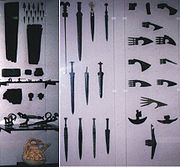
Luristan bronze
Encyclopedia


Lorestān bronze is a term referring to a set of Early Iron Age bronze
Bronze
Bronze is a metal alloy consisting primarily of copper, usually with tin as the main additive. It is hard and brittle, and it was particularly significant in antiquity, so much so that the Bronze Age was named after the metal...
artifacts of various individual forms which have been recovered from Lorestān
Lorestan Province
Lorestan Province is a historic territory and province of western Iran, amidst the Zagros Mountains. The population of Lorestan was estimated at 1,716,527 people in 2006.Lorestan covers an area of 28,392 km²...
and Kermanshah
Kermanshah
Kermanshah is a city in and the capital of Kermanshah Province, Iran. At the 2006 census, its population was 784,602, in 198,117 families.The overwhelming majority of Kermanshahi people are Shi'a Muslims...
areas in west-central Iran
Iran
Iran , officially the Islamic Republic of Iran , is a country in Southern and Western Asia. The name "Iran" has been in use natively since the Sassanian era and came into use internationally in 1935, before which the country was known to the Western world as Persia...
. They include a great number of weapons, ornaments, tools, and ceremonial objects. Were created by the ancient Persian
Persian people
The Persian people are part of the Iranian peoples who speak the modern Persian language and closely akin Iranian dialects and languages. The origin of the ethnic Iranian/Persian peoples are traced to the Ancient Iranian peoples, who were part of the ancient Indo-Iranians and themselves part of...
.
Typical Lorestāni-style objects belong to the (Iranian) Iron Age
Iron Age
The Iron Age is the archaeological period generally occurring after the Bronze Age, marked by the prevalent use of iron. The early period of the age is characterized by the widespread use of iron or steel. The adoption of such material coincided with other changes in society, including differing...
(c. 1250-650 BC). The term "Lorestān bronze" is not normally used to refer to earlier bronze artifacts from Luristan, datable to a period between the fourth millennium BC and the (Iranian) Bronze Age
Bronze Age
The Bronze Age is a period characterized by the use of copper and its alloy bronze as the chief hard materials in the manufacture of some implements and weapons. Chronologically, it stands between the Stone Age and Iron Age...
(c. 2900-1250 BC), when bronze objects from Lorestān were similar to those found in Mesopotamia
Mesopotamia
Mesopotamia is a toponym for the area of the Tigris–Euphrates river system, largely corresponding to modern-day Iraq, northeastern Syria, southeastern Turkey and southwestern Iran.Widely considered to be the cradle of civilization, Bronze Age Mesopotamia included Sumer and the...
and on the Iranian plateau
Iranian plateau
The Iranian plateau, or Iranic plateau, is a geological formation in Southwest Asia. It is the part of the Eurasian Plate wedged between the Arabian and Indian plates, situated between the Zagros mountains to the west, the Caspian Sea and the Kopet Dag to the north, the Hormuz Strait and Persian...
.
In 1930 a large quantity of canonical Lorestān bronze artifacts appeared on the Iranian and European antiquities markets as a result of plundering of tombs in this region. Since 1938 several scientific excavations were conducted by American, Danish, British, Belgian, and Iranian archaeologists on the graveyards with stone tombs in the northern Pish Kuh valleys and the southern Pusht Kuh of Lorestān.
Further reading
- Fleming, S. J., V. C. Pigott, C. P. Swann, and S. K. Nash. Bronze in Luristan: Preliminary analytical evidence from copper/bronze artifacts excavated by the Belgian mission in Iran. Iranica Antiqua: 2005.
- Ghirshman, R. Iran: from the earliest times to the Islamic conquest. Penguin Books: 1954.
- Meier-Arendt, W. Bronzen and Keramik aus Luristan und anderen Gebieten Irans im Museum für Vor- and Frühgeschichte. Frankfurt am Main: 1984.
- Moorey, P. R. S. Ancient Bronzes from Luristan. British Museum: London, 1974.
- Muscarella, O. W. "Bronzes of Luristan." Encyclopedia Iranica. Columbia University Press: 2004.
- Overlaet, B. "Luristan Metalwork in the Iron Age" Persia's Ancient Splendour: Mining, Handicraft and Archaeology. Deutsches Bergbau-Museum: Bochum, 2004.
- Rickenbach, J. Magier mit Feuer und Erz, Bronzekunst der frühen Bergvölker in Luristan, Iran. Museum Rietberg: Zürich, 1992.
- Zahlhaas, G. Luristan: Antike Bronzen aus dem Iran. Archäologische Staatssammlung MünchenBavarian State Archaeological CollectionThe Bavarian State Archaeological Collection in Munich is the central museum of prehistory of the State of Bavaria and one of the most important archaeological collections and cultural history museums in Germany.-History:...
, Museum für Vor-und Frühgeschichte: München, 2002.

